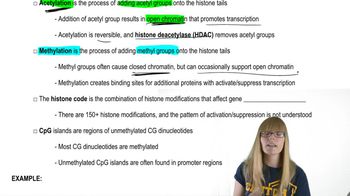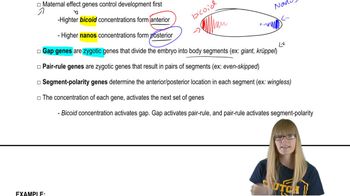Table of contents
- 1. Introduction to Genetics51m
- 2. Mendel's Laws of Inheritance3h 37m
- 3. Extensions to Mendelian Inheritance2h 41m
- 4. Genetic Mapping and Linkage2h 28m
- 5. Genetics of Bacteria and Viruses1h 21m
- 6. Chromosomal Variation1h 48m
- 7. DNA and Chromosome Structure56m
- 8. DNA Replication1h 10m
- 9. Mitosis and Meiosis1h 34m
- 10. Transcription1h 0m
- 11. Translation58m
- 12. Gene Regulation in Prokaryotes1h 19m
- 13. Gene Regulation in Eukaryotes44m
- 14. Genetic Control of Development44m
- 15. Genomes and Genomics1h 50m
- 16. Transposable Elements47m
- 17. Mutation, Repair, and Recombination1h 6m
- 18. Molecular Genetic Tools19m
- 19. Cancer Genetics29m
- 20. Quantitative Genetics1h 26m
- 21. Population Genetics50m
- 22. Evolutionary Genetics29m
13. Gene Regulation in Eukaryotes
Epigenetics, Chromatin Modifications, and Regulation
Problem 22a
Textbook Question
From the data in Table 19.3, draw up a list of histone H3 modifications associated with gene activation. Then draw up a list of H3 modifications associated with repression.
If not, how can you reconcile these differences?
 Verified step by step guidance
Verified step by step guidance1
<span>Step 1: Understand the role of histone modifications in gene expression. Histone modifications, such as methylation and acetylation, can influence whether a gene is active or repressed.</span>
<span>Step 2: Identify the histone H3 modifications that are typically associated with gene activation. Common modifications include acetylation (e.g., H3K9ac, H3K14ac) and certain methylations (e.g., H3K4me3).</span>
<span>Step 3: Identify the histone H3 modifications that are typically associated with gene repression. These often include methylations such as H3K9me3 and H3K27me3.</span>
<span>Step 4: Compare the list of modifications from Table 19.3 with the typical modifications associated with activation and repression. Note any discrepancies or unexpected findings.</span>
<span>Step 5: Consider possible reasons for any differences observed. This could include context-specific roles of modifications, the influence of other histone marks, or experimental conditions that might affect the interpretation of the data.</span>
Recommended similar problem, with video answer:
 Verified Solution
Verified SolutionThis video solution was recommended by our tutors as helpful for the problem above
Video duration:
1mPlay a video:
Was this helpful?
Key Concepts
Here are the essential concepts you must grasp in order to answer the question correctly.
Histone Modifications
Histone modifications refer to the chemical changes to the histone proteins around which DNA is wrapped. These modifications, such as methylation and acetylation, can influence gene expression by altering the accessibility of the DNA to transcription machinery. Specific patterns of histone modifications are associated with either gene activation or repression, making them crucial for understanding epigenetic regulation.
Recommended video:
Guided course

Histone Protein Modifications
Gene Activation and Repression
Gene activation involves the processes that increase the expression of a gene, often facilitated by specific histone modifications that promote a more open chromatin structure. Conversely, gene repression refers to mechanisms that decrease gene expression, typically associated with histone modifications that lead to a more compact chromatin configuration. Understanding these processes is essential for interpreting the data in Table 19.3.
Recommended video:
Guided course

Segmentation Genes
Epigenetic Regulation
Epigenetic regulation encompasses the heritable changes in gene expression that do not involve alterations to the underlying DNA sequence. This includes various mechanisms such as histone modifications, DNA methylation, and non-coding RNAs. Reconciling differences in histone modifications associated with gene activation and repression requires an understanding of how these epigenetic marks interact and influence cellular functions.
Recommended video:
Guided course

Regulation





